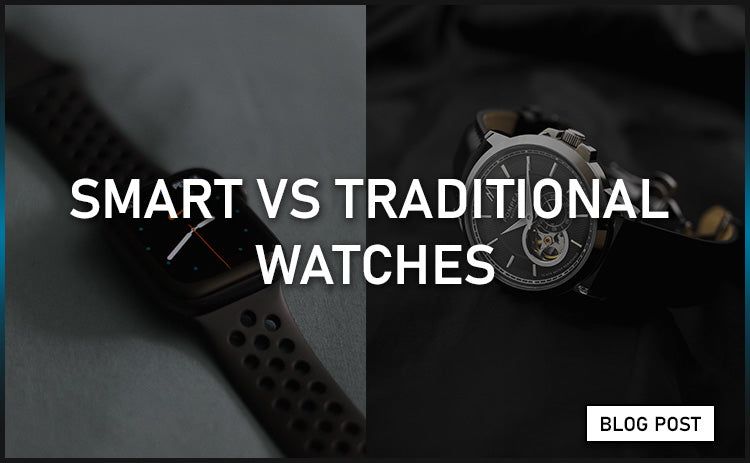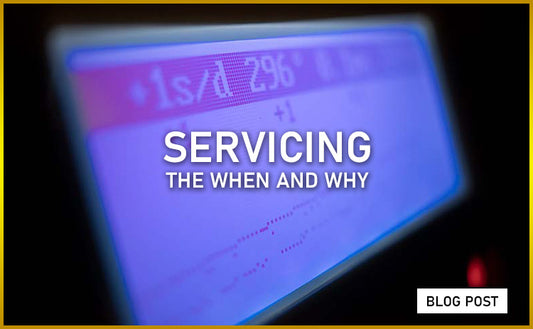
Smart vs Traditional Watches
Share
The recent rise of smartwatches and fitness trackers begs the question: do traditional watches actually offer something that smart watches don't?
To fully answer this question, we need to go right back and look at what makes both watches tick.

Where it all began:
A watch is a small timepiece intended to be carried or worn by a person.
Although the so called Nuremberg eggs were portable clocks used as navigational instruments, they were not really suitable for the wrist.

This all changed during the 16th century when two Swiss mechanics first formed, what is now known as, the main spring - a tightly wound spring used as the power source of mechanical watches. Innovation continued and by the 19th century wristwatches were widely worn as women’s jewellery, with men often opting for the more fashionable pocket watches of the time.
This changed during WWI with the importance of synchronised military manoeuvres and by the end of WWII, public perception of the man’s wristwatch had changed, bringing with it a rise in demand and quality, driving innovations such as unbreakable glass and luminous hands.

1969 saw the introduction of the first Quartz watch - the Seiko Astron. Utilizing cheap and highly accurate movements which replaced the mechanical balance wheel with an electronic, quartz regulated, oscillator.

These watches opened the door for innovations such as the chronograph watch and marked the start of a huge economic shift away from mechanical watches, aptly named the quartz crisis.

A brief history of the smartwatch
Smartwatches are a relatively new invention, with the first watch able to do something, other than tell the time being the T001 created by Seiko in 1983, and made famous by Roger Moore’s James Bond in Octopussy. The T001 allowed users to view video output in a whopping ten shades of grey when linked to a portable TV receiver.

The Seiko data 2000, also released in 1983, allowed users to store up to 2 memo’s, make calendar entries and acted as a calculator – providing you use the clip on keyboard.

In 2001, IBM released the Watchpad 1.5 which had heaps of new features, all considered standard in today’s smartwatch market - Bluetooth, a vibrating mechanism and a touch sensitive display, even a fingerprint sensor.
Garmin smartwatches are well known today their GPS capabilities, first demonstrated in 2003 with the release of the Forerunner. It was capable of measuring speed, distance, pace and calories burned, with a pair of AAA batteries providing 14 hours of run time.

Fast forward to the present day and most of the above features appear in a standard smartwatch for under £300 and manufacturers are cramming more and more into every iteration, at the small expense of battery life.

So why would anyone chose a dumb watch?
At this point you may be thinking a smartwatch is the obvious choice and offers so much that a traditional cannot. That is true, if you want to track your every move, your heart rate or view text messages with a screen on your wrist instead of a screen on your phone. Hell, you can even track how many hours you slept last week. Having owned a number of smartwatches in the past however, there are a few things that mean I am not going back to one anytime soon:
A smartwatch battery can last up to around 36 hours and usually requires daily charging, fine if you pop it on charge every night, but what if you want to track your sleep every night and steps every day??

Compare that to a traditional watch – Quartz watch batteries last for years (yes, years. Pompeaks Debut Collection has a 5 year battery life). A mechanical watch may need winding every day or two, but opt for a self-winding automatic and so long as you wear it, you'll never have to charge it.

The last thing today’s society needs is more distractions and one thing I definitely do not need is my watch buzzing me to look down when I’m in a meeting or trying to have a conversation. I also don’t need to be obviously checking the time with the press of a button or tilt to activate the screen, why not just glance down to the always on display of a traditional watch.

Finally, for me, a smartwatch is yet another screen to look at. A traditional watch can be chosen for extreme conditions or to be a miniature piece of art you carry round to complete your look. Whatever look that may be, you can find a watch to match.

Technology is always being outdated but find a watch you like and it will remain timeless.
Thank you for reading, be sure to let us know what you think in the comments or get in touch with any questions via our contact page.
Want more? Check out our other blogs or follow along on our socials for more.





